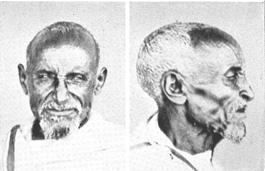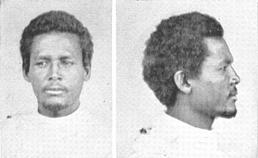ETHIOPIANS
While not a Caucasoid people in the sense that North Africans are, East Africans have long received influences from farther North as well as the Middle East, in terms of both racial and cultural input. This is evidenced by male-mediated gene flow from Caucasoids, which accords with historically documented migrations and settlements.
History
"...an ancient tongue spoken in this region fissured into the modern languages of the Afro-Asiatic (formerly Hamito-Semitic) family. This family includes the Cushitic and Semitic languages now spoken in Ethiopia.... During the 2nd millennium BC...a people speaking Ge'ez (a Semitic language) came to dominate the rich northern highlands of Tigray. There, in the 7th century BC, they established the kingdom of Da'amat.... Aksum's culture comprised Ge'ez, written in a modified South Arabian alphabet, sculpture and architecture based on South Arabian prototypes, and an amalgam of local and Middle Eastern deities. Thus, evidence exists of a close cultural exchange between Aksum and the Arabian peninsula...."("History of Ethiopia," Encyclopaedia Britannica)
Genetics
"The present composition of the Ethiopian population is the result of a complex and extensive intermixing of different peoples of North African, Near and Middle Eastern, and south-Saharan origin. The two main groups inhabiting the country are the Amhara, descended from Arabian conquerors, and the Oromo, the most important group among the Cushitic people. ... The genetic distance analysis showed the separation between African and non-African populations, with the Amhara and Oromo located in an intermediate position."* * *
"The occurrence of E*5 212 and E*5 204 alleles in two populations of the Mediterranean basin (Turkey and Italy) but not in West Africans can be explained by taking into account that the Ethiopian gene pool was estimated to be >40% of Caucasoid derivation (Cavalli-Sforza et al. 1994). In addition, more recent phylogenetic analysis based on classical protein polymorphism (Tartaglia et al. 1996) and Y-chromosome sequence variation (Underhill et al. 2000) showed that Ethiopians appear to be distinct from Africans and more closely associated with populations of the Mediterranean basin."
* * *"Non sub-Saharan African samples are all grouped together...with...the Ethiopian Amharic sample [on the Y-chromosome]. Ethiopians are not statistically differentiated from the Egyptian and Tunisian samples, in agreement with their linguistic affiliation with the Afro-Asiatic family."
* * *
"On the basis of historical, linguistic, and genetic data, it has been suggested that the Ethiopian population has been strongly affected by Caucasoid migrations since Neolithic times. On the basis of autosomal polymorphic loci, it has been estimated that 60% of the Ethiopian gene pool has an African origin, whereas ~40% is of Caucasoid derivation.... Our Ethiopian sample also lacks the sY81-G allele, which was associated with 86% and 69% of Senegalese and mixed-African YAP+ chromosomes, respectively. This suggests that male-mediated gene flow from Niger-Congo speakers to the Ethiopian population was probably very limited ... Caucasoid gene flow into the Ethiopian gene pool occurred predominantly through males. Conversely, the Niger-Congo contribution to the Ethiopian population occurred mainly through females."
(Passarino et al. 1998)* * *
"Notably, 62% of the Ethiopians fall in the first cluster, which encompasses the majority of the Jews, Norwegians and Armenians, indicating that placement of these individuals in a 'Black' cluster would be an inaccurate reflection of the genetic structure. Only 24% of the Ethiopians are placed in the cluster with the Bantu and most of the Afro-Caribbeans."
Racial TypesThough Ethiopians are generally Negroid in pigmentation and hair type, their Caucasoid (Mediterranean) accretions are evident in their cranial and facial morphology, which distinguishes them from pure West African Negroids.

Hamitic-speaker (Gojjam)

Semitic-speaker (Shoa)

Hamitic-speaker (Wollega Galla)
Related Topics
Somalis: Another East African group with Caucasoid affinities similar to those of Ethiopians.
North Africans: Genetic data showing the peoples of North Africa to be predominantly Caucasoid.

